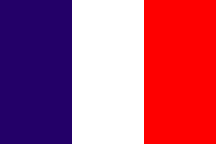
Flags or ribbons with three colours, assumed by nations or insurgents as symbols of political liberty. The present European tricolour ensigns are, for 1
Belgium, black, yellow, red, divided vertically. 2
France, blue, white, red, divided vertically. (See image.) 3
Holland, red, white, blue, divided horizontally. 4
Italy, green, white, red, divided vertically. 5
Tricolour of France. The insurgents in the French Revolution chose the three colours of the city of Paris for their symbol. The three colours were first devised by Mary Stuart, wife of Franois II. The white represented the royal house of France; the blue, Scotland; and the red, Switzerland, in compliment to the Swiss guards, whose livery it was. The heralds afterwards tinctured the shield of Paris with the three colours, thus expressed in heraldic language: Paris portait de gueules, sur vaisseau d’argent, flottant sur des ondes de mime, le chef cousu de France’ (a ship with white sails, on a red ground, with a blue chef). The usual tale is that the insurgents in 1789 had adopted for their flag the two colours, red and blue, but that Lafayette persuaded them to add the Bourbon white, to show that they bore no hostility to the king. The first flag of the Republicans was green. The tricolour was adopted July 11th, when the people were disgusted with the king for dismissing Necker. 6
If you will wear a livery, let it at least be that of the city of Paris’ blue and red. Dumas: Six Years Afterwards, chap. xv.






























